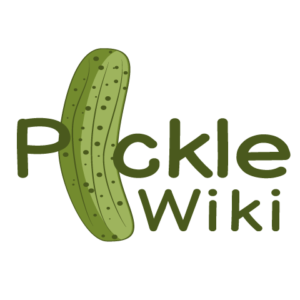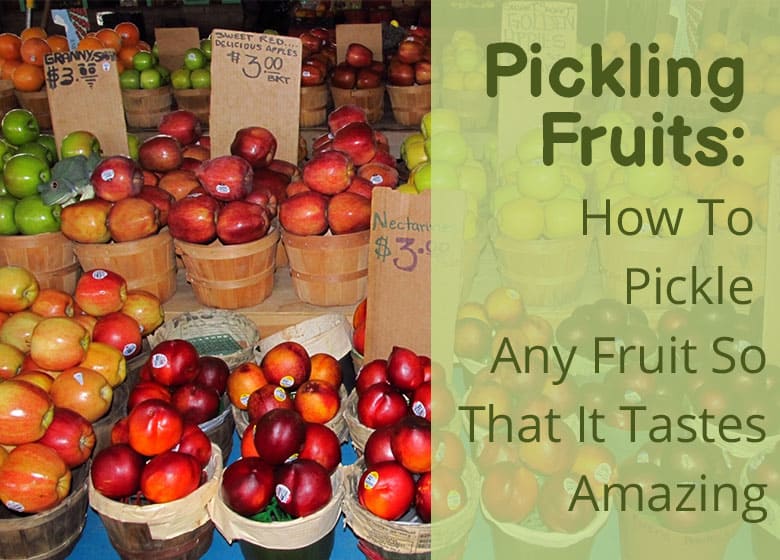Many people think that the only pickle options you have are choosing between dills, kosher, hot, or sweet. While pickled cucumbers are the most common pickles you will find, you can pickle pretty much any sort of fruit or vegetable. However, there are certain types of fruits that are better suited for pickling, and these pickled fruits will taste amazing.
Use a basic brine recipe to pickle any sort of fruit. Add in spices and herbs to compliment the fruit that you are picking. Make sure you use ripe, flavorful, good-quality fruit. The most common fruits to pickle include watermelon, figs, apples, lemons, and tomatoes, but the list is endless.
We’ll help you figure out how to pickle any sort of fruit so that it tastes amazing. We will also tell you some of the best fruits that you can pickle, and how to do it.
How to Pickle Any Fruit
When pickling any fruit or vegetable, the basic process is the same. You cut the fruit or veggie into the desired shape and put it in a jar. Meanwhile, you prepare the brine, then pour it into the jar. From there, you can cap it and store it in the fridge, or go through a canning process for it to be shelf-stable.
Any fruit or vegetable can be pickled in the same brine, no matter what it is. While the results might not be packed with tons of flavor, the fruit or vegetable will be technically pickled.
When pickling, the shortest amount of time you might find for resting is about four hours. Some pickles may need several days to weeks before they’re ready to enjoy. For shorter durations, you may just stick your pickles right into the fridge to consume within a few days or weeks. Refrigerator pickles don’t need a special jar, you can reuse old pickle jars, Tupperware containers, or other storage containers with lids.
However, if you want your pickles to be shelf-stable for months or years, you’ll need to process in a hot water bath. You’ll need mason jars with special lids, which have a wax-like seal on them that sticks the lid to the jar after processing.
Typically, you’ll boil water in a kettle, enough to cover the jars by about an inch. Boil the jars in the water for about 10-15 minutes, depending on the recipe. After removing the jars from the bath and letting cool, you should be able to test the seal to find the lid has been sucked in.
Basic Brine Recipe for Fruit
The basic brine for any pickling recipe will consist of equal parts of vinegar and water, followed by an amount of sugar and salt that is kind of up to each person’s personal preference. Generally, a cup of vinegar and water each with a tablespoon of salt should be enough to brine your vegetables, however, a dash of sugar may be enough for some while others may prefer up to 1/2 cup of sugar.
A basic recipe for brine will look like this:
- One cup water
- One cup vinegar (white or apple cider)
- 1 tbsp of kosher salt
- 1 tsp up to ½ cup of sugar.
To make your brine, combine all of these ingredients into a small saucepan and bring it to a boil. Once a spoiled check to make sure that all of the sugar and salt has been dissolved. Turn off the heat and once the brine has cooled slightly, you can pour it into your jar.
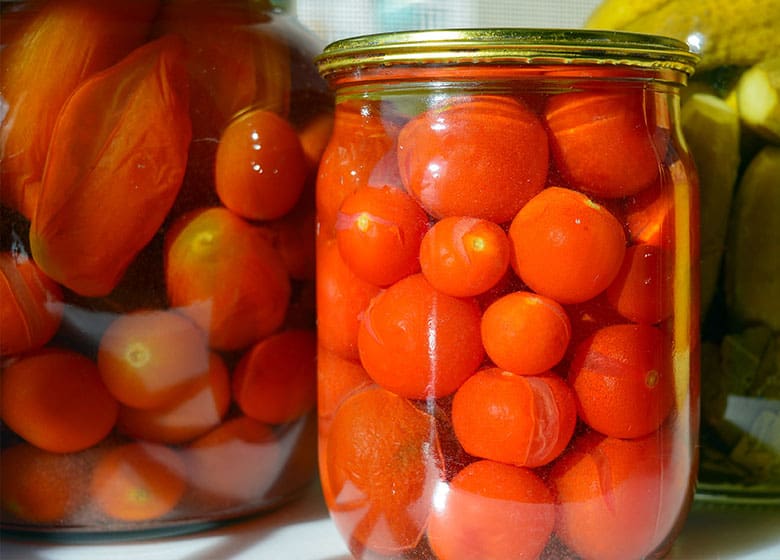
Choosing the Right Fruits to Pickle
When your pickling fruit, you have to make sure that you are picking the best fruit. Since pickling is of the method of preserving, it may be tempting to see fruit that is about to expire and hope to extend the life by pickling them. However, if you pickle fruit that is mushy or overripe, the vinegar or brine solution can just make them less palatable.
Before you start pickling, pick out fruit that is at its prime. When shopping at your local grocery store Farmers Market, take out fruit that is fully ripe but not overwrite. Look for fruit that doesn’t have any blemishes, bruises, mold, or rot. Don’t let them sit too long either before you pickle them.
The types of fruits that you pickle will depend on personal preferences. Almost any type of fruit can be pickled, but some people like certain flavor combinations better than others.
Pickling Spices for Fruit
Birds tend to be higher in sugar than vegetables and therefore the pickling recipes for fruit will usually have more sugar, but also different types of pickling spices. Skip the dill and mustard for most of your pickled fruits, and opt for spices such as cinnamon, allspice, cloves, and nutmeg. You may even consider swapping honey for the sugar in your standard brine recipe.
For creative flavor profiles, consider pickling spice blends like a Curry Pickling Spice blend. KevinIsCooking.com has a sweet and savory blend recipe here. This sweet pickling spice blend is noted to be good for stone fruits, like plums.
For more info on herbs check out this post we wrote about 10 unique herbs that we think will make your pickles stand out.
Different Vinegars for Different Flavor Profiles
Try also mixing up the different types of vinegar depending on the fruit that you use. Apple cider vinegar has a fruitier flavor than white vinegar since it’s made from apples. Balsamic vinegar may be great for pickling berries and melons. Also, consider using white wine or red wine vinegar.
Make sure the vinegar you pick is over 5% acidity to make sure it has enough pickling power to preserve your fruits.
PreserveandPickle lists these options and flavor profiles:
- White Vinegar, for a neutral flavor and won’t impact the color of your fruit
- Malt Vinegar, for bold flavor which can overwhelm lighter flavored fruits and a dark color that can brown bright colors. Likely should avoid this one for pickling fruit.
- Apple Cider Vinegar (or other fruit vinegars), lightly colored and will have a light fruity flavor that is good with many fruits
- Wine Vinegar has a delicate flavor. White wine vinegar may not impact the color of your fruit, but the red will. Consider reviewing flavor notes of the red and white wine to choose which fruit to pair it with.
To learn more about pickling vinegar and which ones are the best check out this article that we wrote here.
The Best Fruits to Pickle
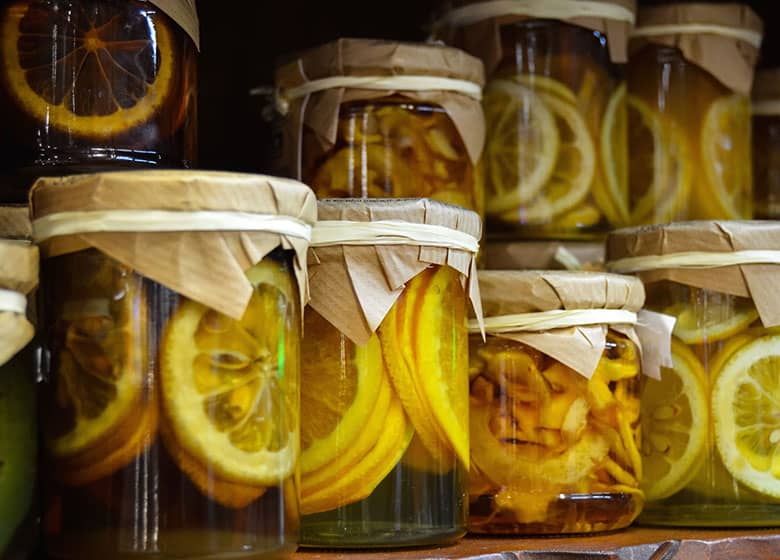
Despite it being physically possible to pickle any fruit, some pickled fruits taste way better than others. If you want your pickled fruit to taste amazing, consider some of these flavorful recipes.
Pickled Watermelon and Watermelon Rinds
One of the most common and popular fruits to pickle is watermelon and watermelon rinds. People will often eat watermelon fresh and discard the rinds. However, pickling these rinds will provide a soft, sweet, and spicy snack.
Alton Brown’s recipe here using apple cider vinegar, allspice, sugar, ginger, star anise, and red pepper flakes for a spicy kick.
To create this recipe, you first cut the rind into one-inch pieces. Then, you boil all the ingredients together first, then add the watermelon rinds and return to a boil before turning off the heat. Once they’ve cooled for 30 minutes, you can fill up your jars and pop them in the fridge. These refrigerator pickled rinds are ready to eat the next day but should be used within a month.
Pickled watermelon isn’t quite as common, but you might find it with the rind still attached. Since watermelon is so fragile, you have to be careful with the heat. This recipe from Imperial Sugar suggests using lemon, thyme, and apple cider vinegar. Don’t skip the ice bath step in the recipe, which prevents the watermelon flesh from getting cooked from the hot brine mixture.
Pickled Figs
Figs can add a depth of flavor to both sweet and savory dishes, but pickled figs can add another level that will wow everyone.
This Spiced Pickled Figs recipe from Spruce Eats can be paired with meat dishes like pork, or can be served with cheese for a high-class charcuterie board.
With the apple cider vinegar and honey, the brine will be slightly syrupy. Clove, nutmeg, cinnamon, and cardamom give this a slightly Indian or Middle Eastern vibe. The figs cook in this mixture so that they’re nice and tender and also absorb all the syrup and brine goodness.
If you want to elevate your next Italian dinner night, try pickling figs with balsamic vinegar. This recipe from GlobalTableAdventure uses balsamic vinegar, honey, peppercorns, and a sprig of rosemary or thyme. You can use it for antipasto, in a salad dressing, or just as an aperitif!
Pickled Spiced Apples
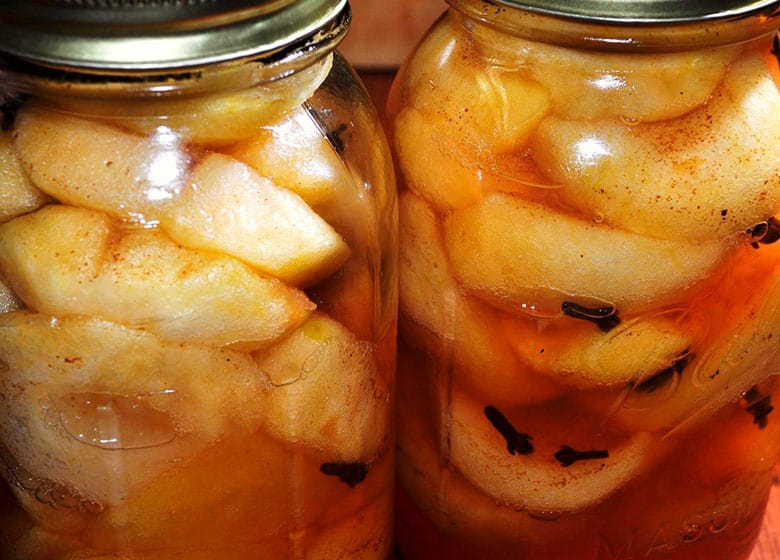
This spiced apple recipe from FrontierCoop.com combines apple pie spices and basic white vinegar to compliment the tart flavors in a green apple with the sweetness of honey and warmth of the cinnamon and spice blend.
Different from many other pickling recipes, you cook the apples in the pickling brine and honey to create a syrup like brine and soft, tender apples. In this one, the recipe also provides instructions for how to process the canned fruit in a water bath so that they are shelf-stable for many months to years.
Once you crack one open, these pickled spice apples will be wonderfully reminiscent of apple pie filling.
Pickled Lemons
Middle eastern, Indian, and Moroccan cultures have a long history of preserving lemons by pickling them. There are a few variations on this preserving method. However, these methods use a lot of salt to create a savory lemon preserve to be used with meat dishes, salads, and garnishes. They are not meant to be sweet or served with desserts!
In OMGYummy.com’s recipe, the lemons are paired with rosemary, thyme, peppercorns, and option red pepper flakes. You cut the lemons into quarters, without separating the quarters, and stuff them full of salt. You then put the salted lemons into a jar and let them sit for a week. Over time, the salt will extract juice from the lemons. After a week, you top of the jar with your spices and fill with lemon juice with a splash of olive oil.
Other spices to consider include coriander, cardamom, star anise, cinnamon, even whole peppers, depending on your taste.
This recipe takes a bit longer than many of the other ones. Once you fill-up the jars at the end of the first week, you’ll need to wait another 3-4 weeks before enjoying them. By then, the wait will be worth it!
Pickled Mango Relish
Known by a range of names, pickled mangos may be described as a relish or chutney when the pieces are cut up small. With larger, bit piece mango pieces, this pickled fruit can be served alongside savory dishes rather than on top as a garnish.
Common to many pickled mango recipes, ginger is an important ingredient. Some recipes may include a sweet syrup, kick up the heat with peppers, or add other aromatics.
This recipe from Mango.org uses unripe mangos, onions, garlic, ginger, lime, apple cider vinegar as well as a red Fresno chili in each jar. The sweet mango, acid from the vinegar and lime, and savory aromatics will make this perfect to serve at your next summer BBQ.
Pickled Tomatoes
Yes, tomatoes are considered a fruit and are a popular fruit to pickle, as well. It’s a great way to preserve a batch of cherry tomatoes if you have too many, such as a prolific cherry tomato plant, but pickled tomatoes can be used in a host of tomato recipes.
Like watermelon, tomato flesh is very delicate and can easily turn to mush. Make sure you use firm, ripe tomatoes that might pop rather than mush if you squeeze them. A basic recipe from thekitchn.com uses a simple brine, adding a bit of garlic and peppercorns for a little added spice. Apple cider vinegar also goes will with these flavors.
More flavorful recipes may include rosemary, lemon, bay, parsley, or other spices that you might use in other tomato-based recipes.
Pickled Pears
Pears can be pickled similarly to apples, so if you want a syrupy sweet pear to serve alongside cheeses or with dessert, try the same recipe as our Pickled Spiced Apples above. However, if you want a slightly less sweet pickled pear, try pairing a few different spices.
WhatShouldIMakeFor.com provides a recipe for quick pickled pears that include spices such as cloves and peppercorn for darker hints of spices.
The benefit of this recipe is that the pears absorb the pickling brine quickly. Pop them in the refrigerator just four hours before serving, which makes them a great option to serve alongside other dishes the same day.
Pickled Berries
Pickled berries can have a huge range of flavor profiles to complement any dish. Recipes include a wide range of ingredients, including fish sauce, radishes, even honey, and cinnamon.
This Honest-Food.net recipe is a straightforward pickling recipe with champagne vinegar, salt, and sugar. That’s it. The basic recipe might be on the tangy side but suggests that if you double the amount of sugar from three tablespoons to six, then you can use it for desserts, such as a drizzle over icecream.
Bonappitet.com takes a more savory approach with their Asian inspired pickled blackberry recipe. They use champagne vinegar with fish sauce, sugar, and water. They skip the traditional boiling process to just shake the jar until combined. In four hours or so, the blackberries will have absorbed the brine, and the resulting liquid can be used in salad dressings.
Experiment with your Own Pickled Fruit Recipes
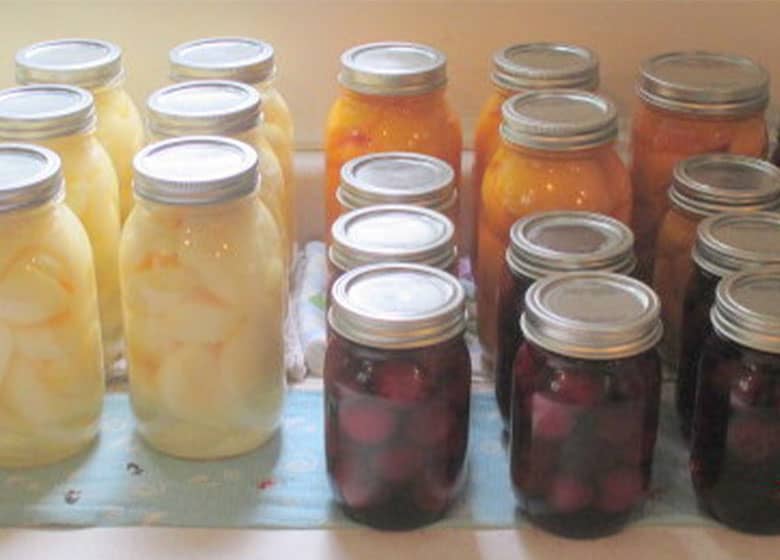
Since almost all types of fruit can be pickled, feel free to experiment with your own combinations. A good rule of thumb for your recipes is to maintain a one to one ratio on your water and vinegar ratio, but then feel free to adjust the sugar, salt, and spices for your own tastes.
Here are a few more suggestions for building your own recipes:
- With softer fleshed fruits, such as grapes, tomatoes, watermelon, or berries, be careful not to heat the fruit too much. Cool down the brining liquid before pouring into your packaged jars, or skip the water when boiling to opt for an ice bath instead.
- To get inspiration on what spices or aromatics you want to use, look up recipes that use the fruit you want to use. For example, if you like blackberry pie? Try pickling blackberries with added cinnamon and lemon. Feeling some strawberry shortcake? Consider pickling strawberries with honey and a whole vanilla bean.
- Play with the timing. Some flavors may peak after a few hours, or overnight, in the fridge, while others may need several weeks to develop. If you’re experimenting with a new recipe, consider packing smaller jars and taste testing them at different intervals.
Pickle Any and Every Fruit!
While not many people know that you can pickle fruit at all, most assume your options are limited to the commonly pickled watermelon rind. Pickled fruit is an excellent way to preserve fresh fruits but also a way to experiment with different flavors.
Try out your own recipes to wow your family or guests at your next dinner! With our tips, tricks, and recipe suggestions, your pickled fruit will taste amazing.
